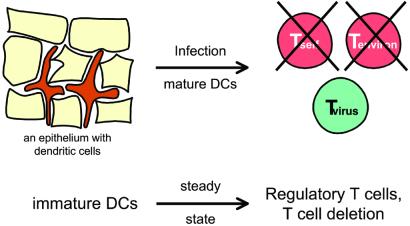Figure 3.
Overcoming the risk of autoimmunity and horror autotoxicus inherent to the maturation of DCs on exposure to pathogens. During infection, DCs mature, e.g., in response to pathogen signals via TLRs (Fig. 2). However, the maturing DCs will likely be presenting peptides not only from the pathogen but also from dying self tissue and innocuous environmental proteins. To overcome this risk, it is proposed that immature DCs induce antigen-specific peripheral tolerance in the steady state, before DC maturation during inflammation and infection. DCs can do so by deleting naïve T cells or inducing regulatory T cells. The tolerized T cells can either be self-reactive lymphocytes that have escaped central tolerance or T cells reactive to innocuous proteins in the environment.

